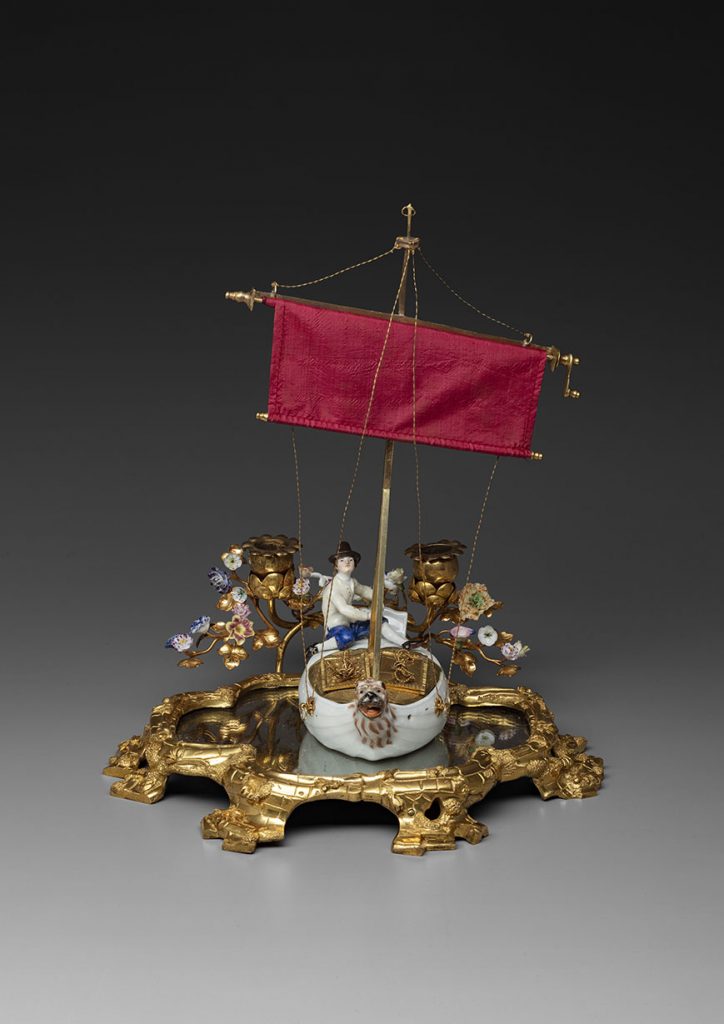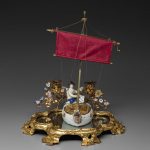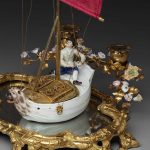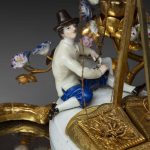A louis xv gilt bronze-mounted Meissen porcelain inkstand and two-light candelabra

A louis xv gilt bronze-mounted Meissen porcelain inkstand
and two-light candelabra
circa 1740-1745
The hard paste Meissen porcelain boat 18th Century
Height: 37 cm. (14 ½ in.) Width: 32 cm. (12 ½ in.) Depth: 27.5 cm. (10 ¾ in.)
Comparative literature
A similar Meissen inkstand illustrated in Drouot l’Art et les Enchères 1984-1985, p. 163, was later sold De Baecque et Associés, Drouot, Paris, 13 October 2021, lot 376.
The role of the marchands-merciers in the creation of meissen porcelain objects
The refined sophistication of 18th century French interior decoration comes about through the close collaboration between the marchands-merciers and a veritable network of Parisian artisans with unparalleled savoir-faire.
Under Louis XV in Paris, the powerful corporation of marchands-merciers constantly invented new luxurious objects for a wealthy clientele eager for unique pieces and innovative taste. These rare objects adorned with Meissen porcelain are magnificent testimonies to the boundless imagination of these French merchants. Truly designers in the modern sense, they had the idea of combining gilt bronze and Meissen porcelain which was particularly popular with great amateurs in the early part of the reign of Louis XV.
The fashion for porcelain flowers soon prompted the marchands-merciers to incorporate them as well in all sorts of forms: clocks, fountains, candelabras and candlesticks, pot pourris, bird cages, chandeliers, lanterns and inkstands. Rapidly, a few reputable merchants specialised in these items adorned with delicate porcelain flowers initially from Meissen itself or soon after from the recently established factory at Vincennes then Sèvres.
One of them, Michel-Joseph Lair (1732-1759), recorded at rue du Roule under the sign of Le Roy des Indes, was a “privileged merchant and ceramicist (faïencier) to the King”. Many items of Meissen porcelain remained in his stock at the time of his death, including several clocks fitted with watch movements, foliage and Meissen porcelain figures.
Edme Choudard-Desforges was another faïencier in the Meissen porcelain trade also located in the rue du Roule. The inventory of his store, drawn up in December 1759, lists a quantity of porcelains from Saxony (as Meissen was known in the 18th century), some of which are richly mounted, as well as a few clocks supported by various porcelain subjects. Based in the rue Saint-Honoré, Jacques-François Machart (active 1744-1763) enjoyed a prestigious clientele and presented in his shop elegant objects of art in Meissen porcelain magnificently mounted in gilt bronze. Machart employed the best Parisian workshops of bronziers and gilders.
Finally, there is Lazare Duvaux (ca. 1703-1758) – undoubtedly the most famous Parisian marchand-mercier – who was based in rue Saint-Honoré under the sign of the Chagrin de Turquie. Duvaux counted among his clients Louis XV and Madame de Pompadour, all the high aristocracy and the circle of powerful financiers. His business was prosperous and the purchases of his many customers are known from the famous “livre-journal du marchand bijoutier ordinaire du Roy”, which still survives.
Vincent Bastien, Doctor in History of Art




